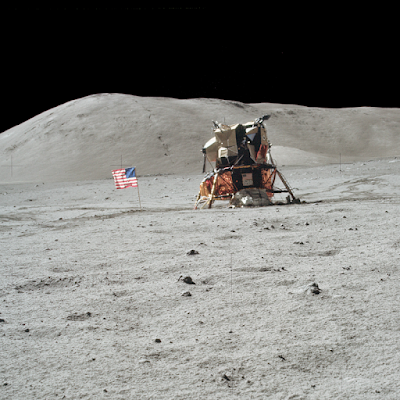From left to right, Juan Leon, representating Congressman Steve Israel (2nd CD), Pat McMahon; sector vice president and general manager, Northrop Grumman Aerospace Systems Battle Management and Engagement Systems Division, Dr. Charles Rubenstein; director, IEEE Region 1, and Martha Sosnowski; regional assistant for U.S. Senator Kirsten Gillibrand (NY) following the unveiling of the bronze plaque honoring the Grumman-made Apollo lunar module [Northrup Gruman].
On the 42nd anniversary of Apollo 11 Commander Neil A. Armstrong's first steps on the moon's surface, Institute of Electrical and Electronics Engineers (IEEE), the world's largest technical professional association, today honored Northrop Grumman (NYSE:NOC) with its IEEE Milestone in Electrical Engineering and Computing award in recognition of the company's work on the lunar module.
The Apollo lunar module, America's first vehicle to enable astronauts to land on the moon and return safely to earth, was designed, developed and built by Grumman Corporation on Long Island. Between 1969 and 1972, six Grumman lunar modules carried 12 astronauts to and from the surface of the moon, including the famed Eagle which first carried Commander Armstrong and Lunar Module Pilot Buzz Aldrin to the Sea of Tranquility. They returned to Earth on July 24, 1969. One module – Aquarius – served as a lifeboat for three astronauts, Jim Lovell, Jack Swigert and Fred Haise, during the ill-fated Apollo 13 mission, which never landed on the moon but returned safely to earth.
The Apollo lunar module, America's first vehicle to enable astronauts to land on the moon and return safely to earth, was designed, developed and built by Grumman Corporation on Long Island. Between 1969 and 1972, six Grumman lunar modules carried 12 astronauts to and from the surface of the moon, including the famed Eagle which first carried Commander Armstrong and Lunar Module Pilot Buzz Aldrin to the Sea of Tranquility. They returned to Earth on July 24, 1969. One module – Aquarius – served as a lifeboat for three astronauts, Jim Lovell, Jack Swigert and Fred Haise, during the ill-fated Apollo 13 mission, which never landed on the moon but returned safely to earth.
The last lunar module to land on the Moon, Apollo 17's Challenger, photographed by Dr. Harrison Schmitt from their lunar rover in December 1972 [AS17-124-20508].
Read the Full Press Release HERE.
Read the Full Press Release HERE.



2 comments:
Might want two "mm"s in Grumman for the entry title! I grew up there during it and was told no one had the "big picture" since it was made in many machine shops around Long Island, according to one assigned to coordinating their production. Legend?
Oops. (I knew better than that. It's been a long week.) Corrected.
Come to think of it, I vaguely remember having heard some mention of just that history, over the years, perhaps in spotlights on the development of the Ascent Stage bell, and perhaps also the materials research. The very definition of cutting edge technology in that time.
Still my all-time favorite space vehicle. Scrapping Altair is a matter of some grief for me.
Post a Comment